Health and homelessness in Scotland: research
Study exploring the relationship between homelessness and health.
Chapter 9: Deaths
There were around 23,700 deaths over the time period 1 April 2002 to 31 March 2015 inclusive for the 1.3 million people in the study. For more information on NRS Vital Events – Deaths data see Section 2.3.9.
In this chapter we discuss the study cohorts, how many died and their causes, and how this relates to homelessness. How this relates to deprivation and health needs is discussed in Chapter 11.
9.1 Comparative mortality between the EHC and their controls
Accounting for one third of all people in the study, people in the EHC (Ever Homeless Cohort) accounted for 60% of deaths (42% male, 17% female). Deaths amongst the MDC (Non-homeless 20% Most Deprived Cohort) accounted for 29% of deaths during the period (18% male, 11% female). The LDC (Non-homeless 20% Least Deprived Cohort) accounted for 11% of deaths (7% male, 4% female).
Table 9.1: Number of people, number of deaths and the ratio of the number of deaths between EHC and MDC, and between EHC and LDC, by age and sex.
| Age (at 31 March 2015) | Male | Female | ||||||
|---|---|---|---|---|---|---|---|---|
| Number of people | Deaths | EHC : MDC | EHC : LDC | Number of people | Deaths | EHC : MDC | EHC : LDC | |
| 0 to 15 | 135,444 | 104 | 1.0 | 2.6 | 127,461 | 105 | 0.7 | 1.9 |
| 16 to 20 | 49,263 | 79 | 1.1 | 2.9 | 51,276 | 32 | ||
| 21 to 25 | 64,209 | 285 | 2.9 | 7.1 | 78,690 | 159 | 2.9 | 4.0 |
| 26 to 30 | 75,363 | 631 | 4.8 | 10.3 | 93,003 | 295 | 2.8 | 12.1 |
| 31 to 35 | 70,407 | 964 | 5.0 | 18.3 | 74,493 | 378 | 3.9 | 15.0 |
| 36 to 40 | 58,347 | 1136 | 4.4 | 21.8 | 53,259 | 464 | 3.7 | 13.8 |
| 41 to 45 | 55,737 | 1479 | 3.3 | 13.0 | 48,873 | 628 | 2.9 | 9.6 |
| 46 to 50 | 49,818 | 1710 | 3.3 | 13.1 | 43,563 | 779 | 2.3 | 6.8 |
| 51 to 55 | 37,746 | 1666 | 2.6 | 9.5 | 31,578 | 787 | 1.7 | 5.1 |
| 56 to 60 | 25,017 | 1615 | 2.1 | 7.4 | 19,017 | 757 | 1.5 | 4.6 |
| 61 to 65 | 15,765 | 1553 | 1.9 | 6.0 | 11,436 | 670 | 1.4 | 3.5 |
| 66 or over | 21,591 | 4834 | 1.4 | 2.6 | 16,203 | 2608 | 1.0 | 2.0 |
| Total (ALL) | 658,707 | 16056 | 2.3 | 6.1 | 648,852 | 7662 | 1.7 | 4.0 |
In order to see how mortality compare in the different cohorts, ratios of deaths were constructed for each age band and sex ( Table 9.1).
Among all cohorts the number of deaths per 1,000 people increases with age ( Figure 9.1)
The EHC have more deaths
In total, the EHC has around twice the number of deaths compared with the MDC (2.3 times for males, 1.7 for females) and around five times the number of deaths compared with the LDC (6.1 times for males, 4.0 times for females).
For each age and sex breakdown among adults (those aged 16+ years), the EHC have at least as many deaths
Compared to the controls in the MDC or LDC, the ratio of deaths is always at least one (minimum ratio is: 1.0, EHC : MDC for females aged 66+ years).
If EHC people die, they tend to die at a younger age than their controls
The ratios for those age 26–50 years are larger than the ratios for those aged over 50 years. However, the data in the study provides no evidence to suggest that the overall life expectancy of EHC is different from their controls. Given that less than 2% of the cohorts died during the study period, the cohorts would need to be followed over a longer much period of time in order to compare their overall life expectancies.
EHC people aged 31–40 years have the most deaths compared with their controls
The ages at which the peak ratios occur are similar for males and females ( Figure 9.2). For males EHC : LDC peaks at 21.8 at 36–40 years, and EHC : MDC peaks at 5.0 at 31–35 years. For females EHC : LDC peaks at 15.0 at 31–35 years, and EHC : MDC peaks at 3.9 also at 31–35 years.
Figure 9.1: Deaths per 1,000 people during study period by age at 31 March 2015, cohort and sex.
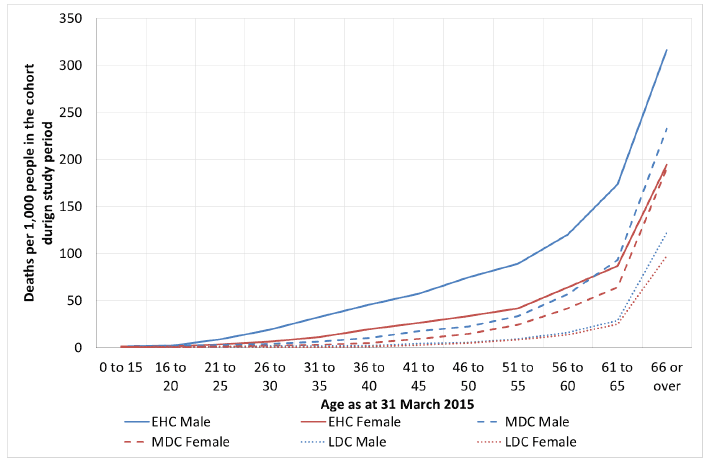
Figure 9.2: Ratio of deaths per 1,000 people in each cohort to those in the LDC by age at 31 March 2015 and sex.
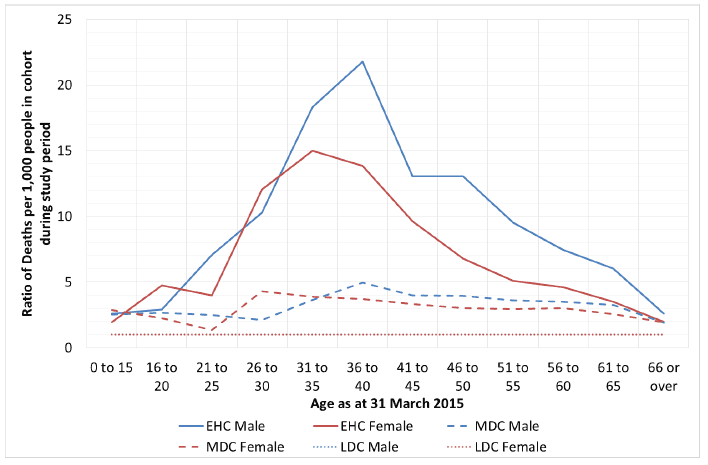
9.2 Cause of death
The previous section found that, on average, more people in the EHC had died than in the control cohorts. This section explores how these ratios vary by cause of death (Table 9.2). Also explored is whether the distribution of the causes of death differs between the cohorts ( Figure 9.3). The following points apply for both sexes:
Table 9.2: Number of people, number of deaths and the ratio of the number of deaths between EHC and MDC, and between EHC and LDC, by cause of death and sex.
| ICD-10 Cause of death | Male | Female | ||||
|---|---|---|---|---|---|---|
| Deaths | EHC : MDC | EHC : LDC | Deaths | EHC : MDC | EHC : LDC | |
| Other causes | 2221 | 2.2 | 4.7 | 1115 | 1.4 | 3.2 |
| Alcohol Related Conditions | 1850 | 3.7 | 33.9 | 676 | 3.6 | 18.8 |
| Drug Related Conditions | 2620 | 7.7 | 73.9 | 856 | 7.6 | 67.9 |
| Mental and Behavioural Disorders | 124 | 1.5 | 2.1 | 114 | 1.7 | 1.7 |
| Diseases of the Respiratory System | 1122 | 1.5 | 5.7 | 731 | 1.2 | 5.6 |
| Malignant Neoplasm (Cancer) | 2999 | 1.2 | 2.2 | 2205 | 1.1 | 1.9 |
| Heart Disease & strokes | 3327 | 1.6 | 4.2 | 1324 | 1.2 | 3.2 |
| Intentional Self-Harm | 927 | 3.5 | 8.2 | 262 | 4.0 | 7.9 |
| Assault | 274 | 6.1 | 64 | 4.6 | ||
| Diseases of the digestive system | 592 | 2.1 | 6.6 | 315 | 1.4 | 4.9 |
| All Causes | 16056 | 2.3 | 6.1 | 7662 | 1.7 | 4.0 |
Note: See section 2.3.9 for details of how the ICD-10 codes were mapped to these groupings.
In order to see how mortality compare in the different cohorts, ratios of deaths were constructed for each age band and sex ( Table 9.1).
All the ratios for drugs, alcohol, intentional self-harm, and assault are higher than the all-cause ratio
For each of drug-related deaths, alcohol-related deaths, intentional self-harm and assault the ratios of each of EHC : MDC and EHC : LDC for both males and females are higher than the respective ratios for the all-cause total (2.3 and 6.1 for males, 1.7 and 4.0 for females).
All the ratios for cancer are notably lower than the all-cause ratio
The EHC : MDC ratio for cancer was 1.2 for males (1.1 for females), and the EHC : LDC ratio for cancer was 2.2 for males (1.9 for females).
The three causes with the most deaths among the male EHC are drugs, heart disease & strokes, and alcohol
22.8% of deaths among the male EHC were due to drug-related conditions, 17.6% were due to heart disease and strokes, and 14.2% were due to alcohol-related conditions ( Figure 9.3). By contrast the three main causes of death among the male MDC and LDC are cancer, heart disease & strokes, and other causes.
The three largest causes of death among the female EHC are cancer, drugs, and heart disease & strokes
21.9% of deaths among the female EHC were due to cancer, 18.0% were due to drug-related conditions, and 14.8% were due to heart disease and strokes. By contrast the three main causes of death among the female MDC and LDC are cancer, heart disease & strokes, and other causes.
Figure 9.3: Number of deaths per 1,000 people by cause of death, cohort and sex.
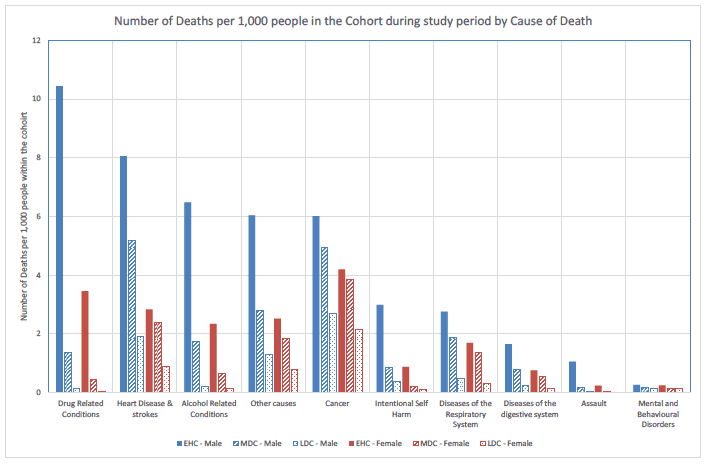
9.3 Cause of death by age and sex
It was found in Section 9.2 that deaths caused by drug-related conditions, alcohol-related conditions and intentional self-harm showed the largest differences between the EHC and the control cohorts. This section explores the deaths per 1,000 people in the study period from these causes by age at 31 March 2015 ( Figure 9.4: drugs, Figure 9.5: alcohol and Figure 9.6: intentional self-harm). This will show whether the EHC people who die from these causes tend to be old or young. The following points apply for both sexes:
Mortality from alcohol is higher for older people, peaking at 61–65 years
The deaths per 1,000 people from alcohol-related conditions are highest among people aged 61–65 years across each of the cohorts (apart from male LDC where the peak occurs in 66+ years) and this is much higher than among younger people. The shape of the distribution is similar in the EHC to those in the controls ( Figure 9.4). Thus EHC people of particular ages are not especially affected by alcohol. It appears that the differences between cohorts are similar across ages. Because most alcohol deaths generally are among older people this is translated across to most alcohol deaths among the EHC being for older people.
Mortality from drugs is higher for people, particularly males, around 31–50 years
The deaths per 1,000 people from drug-related conditions are highest among people, particularly males, aged around 31–50 years ( Figure 9.5).
Mortality from intentional self-harm is higher for people, particularly males, around 31–50 years
The standardized deaths from intentional self-harm are highest among people, particularly males , aged around 31–50 years ( Figure 9.6).
Figure 9.4: Alcohol related deaths per 1,000 people by cohort, age at 31 March 2015 and sex. Note: A logarithmic scale has been used here to highlight that the cohort distributions are similar (the lines are approximately parallel).
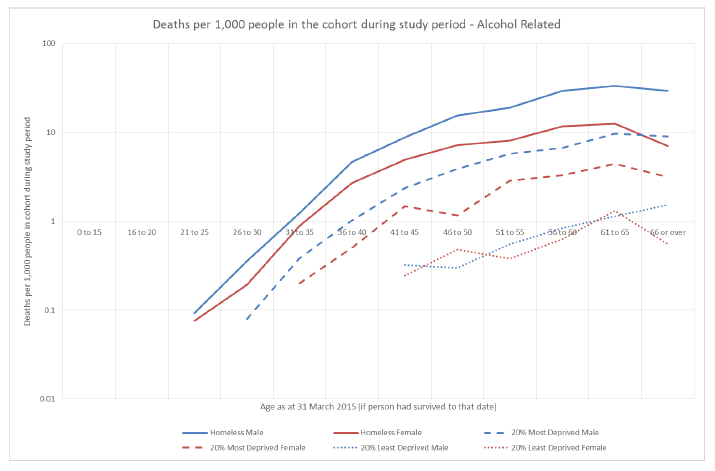
Figure 9.5: Drug related deaths per 1,000 people by cohort, age at 31 March 2015 and sex.
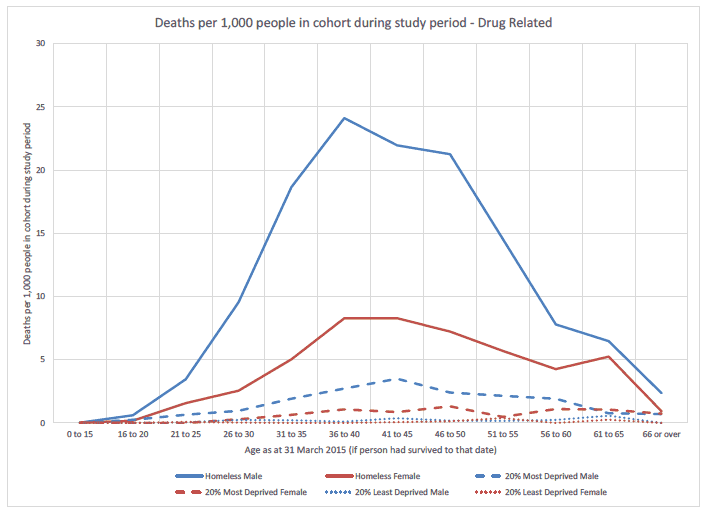
Figure 9.6: Intentional self-harm deaths per 1,000 people by cohort, age at 31 March 2015 and sex.
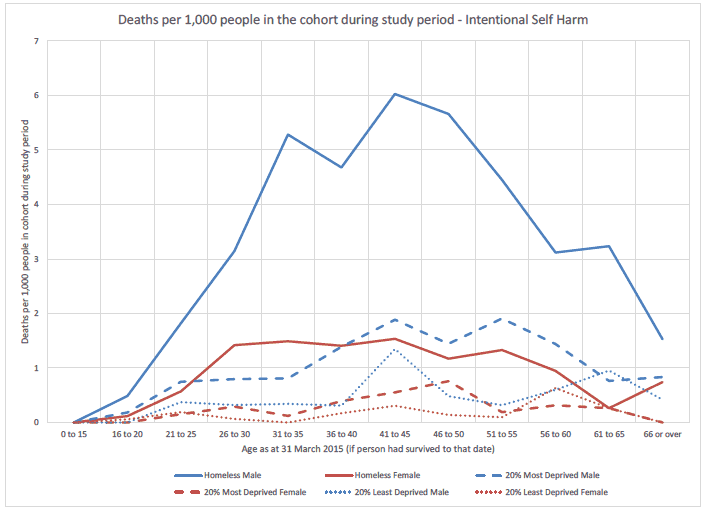
9.4 Cause of death for Once-Only and Repeat Homelessness
In order to see how mortality compares in for the Repeat and Once-only EHC the distribution of deaths by cause are analysed separately for these ( figures 9.7 and 9.8). Also the ratios of deaths were constructed for each cause and sex ( tables 9.3 and 9.4), for Repeat and Once-only EHC.
The three causes with the most deaths among the Repeat EHC are drugs, alcohol and other causes
37% of deaths among the male EHC (33% female) were due to drug-related conditions, 14% (male and female) were due to alcohol-related conditions, and 13% (male and female) were due to other causes ( Figure 9.8).
The three causes with the most deaths among the Once-only EHC are heart disease & strokes, cancer, and drugs (males) or other causes (females)
For male Once-only EHC the three main causes of death ( Figure 9.7) are heart disease & strokes (20%), cancer (17%), and drugs (15%). For female Once-only EHC the three main causes of death are cancer (25%), heart disease & strokes (17%) and other causes (13%).
The Repeat EHC have larger differences in mortality between the EHC and controls than do the Once-only EHC
The reason that there are more drug-related deaths among the Repeat EHC than among the Once-only EHC will partly be that the Repeat EHC has a younger age distribution (the deaths per 1,000 people is higher among younger people ( Figure 9.5). However it is also seen that the ratios EHC : LDC and EHC : MDC for drug-related conditions (which control for age) are higher for the Repeat cohorts than for the Once-only cohorts (11.6 compared with 5.6 for males, and 12.3 compared with 5.4 for males – see Tables 9.3 and 9.4). If differences in age alone were the driver, we would not expect these ratios to differ by more than a factor of 1.4 times – see section 2.3.2 ). Previous chapters have also shown evidence of higher drug-related health activity for Repeat EHC (see section 8.4: SDMD Assessments). Thus this will also account for the prominence of deaths among the Repeat EHC.
Figure 9.7: Deaths per 1,000 people for once only homelessness people by cause of death, cohort and sex.
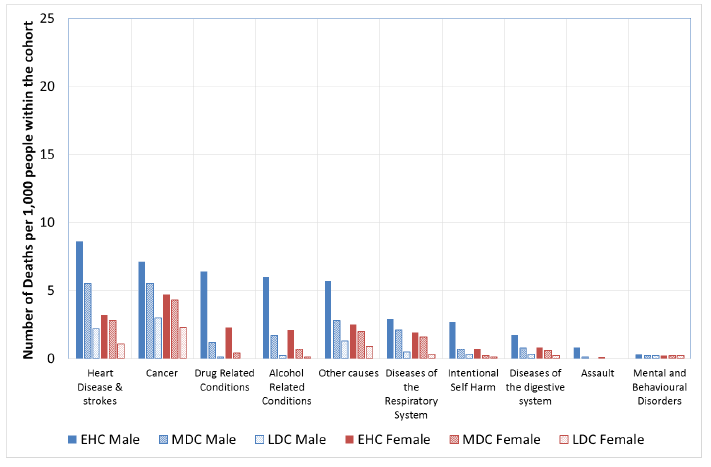
Figure 9.8: Deaths per 1,000 people for people with repeat homelessness assessments by cause of death, cohort and sex.
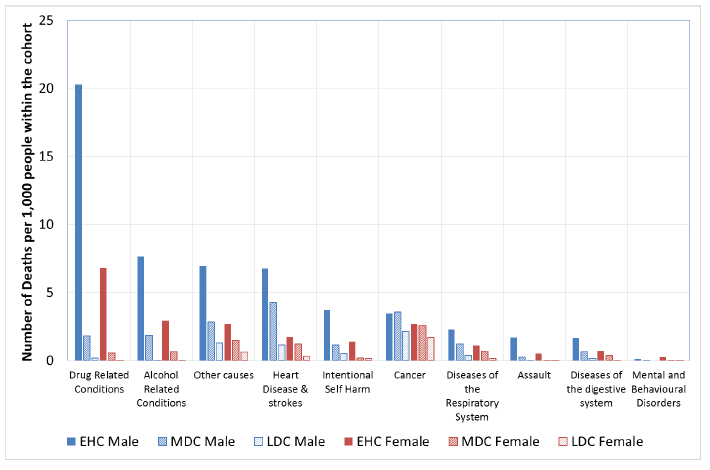
Table 9.3: Deaths per 1,000 people for males with homelessness assessments by cause of death, cohort and sex.
| Age (at 31 March 2015) | Repeat | Once only | ||||
|---|---|---|---|---|---|---|
| Deaths | EHC : MDC | EHC : LDC | Deaths | EHC : MDC | EHC : LDC | |
| Drug Related Conditions | 1,417 | 11.0 | 117.2 | 1,203 | 5.6 | 50.2 |
| Heart Disease & strokes | 778 | 1.6 | 5.8 | 2,549 | 1.5 | 3.8 |
| Other causes | 702 | 2.5 | 5.5 | 1,519 | 2.0 | 4.4 |
| Alcohol Related Conditions | 611 | 4.1 | 1,239 | 3.5 | 26.0 | |
| Cancer | 582 | 1.0 | 1.6 | 2,417 | 1.3 | 2.4 |
| Intentional Self-harm | 343 | 3.2 | 7.4 | 584 | 3.6 | 8.8 |
| Diseases of the Respiratory System | 248 | 1.9 | 5.8 | 874 | 1.4 | 5.7 |
| Diseases of the digestive system | 155 | 2.5 | 437 | 2.0 | 5.6 | |
| Assault | 125 | 7.1 | 149 | 5.4 | ||
| Mental and Behavioural Disorders | 11 | 113 | 1.5 | 1.8 | ||
| Total (ALL) | 4,972 | 3.1 | 9.2 | 11,084 | 2.0 | 5.2 |
Table 9.4: Deaths per 1,000 people for females with homelessness assessment by cause of death cohort and sex.
| Age (at 31 March 2015) | Repeat | Once only | ||||
|---|---|---|---|---|---|---|
| Deaths | EHC : MDC | EHC : LDC | Deaths | EHC : MDC | EHC : LDC | |
| Drug Related Conditions | 418 | 12.3 | 438 | 5.4 | ||
| Cancer | 391 | 1.0 | 1.6 | 1,814 | 1.1 | 2.0 |
| Other causes | 268 | 1.8 | 4.3 | 847 | 1.3 | 2.9 |
| Alcohol Related Conditions | 204 | 4.6 | 472 | 3.2 | 14.9 | |
| Heart Disease & strokes | 182 | 1.4 | 5.3 | 1,142 | 1.1 | 3.0 |
| Diseases of the Respiratory System | 110 | 1.6 | 621 | 1.2 | 5.4 | |
| Intentional Self-harm | 97 | 7.1 | 165 | 3.0 | 7.0 | |
| Diseases of the digestive system | 64 | 1.9 | 251 | 1.3 | 4.1 | |
| Assault | 33 | 31 | ||||
| Mental and Behavioural Disorders | 18 | 96 | 1.3 | 1.4 | ||
| Total (ALL) | 1,785 | 2.6 | 6.4 | 5,877 | 1.4 | 3.5 |
9.5 Time of death relative to homelessness
In previous chapters in order to explore how homelessness itself is related to the health measure, temporal plots of health activity relative to the date of first homelessness assessment were produced. These showed how health activity following the date of first homelessness assessment compared with that before this date. However such analysis will not be possible for deaths. This is partly because there are comparatively few deaths, but also because there are no deaths prior to the first assessment date (by construction of the datasets).
Therefore, in order so explore the link between homelessness and deaths, the number of deaths that occurred while people in the EHC were homeless is compared with the number of death for these people while they were not homeless (Table 9.5). Here people are considered to be homeless from the date of homelessness assessment until the date that the local authority has discharged its duties under the homelessness legislation and closed the HL1 case. Note that this method is not as robust as the previous temporal analysis as it does not control for the effects of aging and other potential issues, such as different recording practices by local authorities. However it should give an indication of whether there is a difference.
Table 9.5: Number of days people in the EHC spent during open homelessness cases from the date of their first homelessness assessment until the end of the study period (31 March 2015), or their date of death (whichever is earlier). People are considered to be in open homelessness cases from the date of homelessness assessment until the date the HL1 case was closed. Also shown is the number of days these people were not in open homelessness cases. For each of these periods the number of deaths that occurred among these people are shown. Finally a death rate is calculated for each of these periods. This has been calculated by dividing the number of deaths in these periods by the total time (converted to years) and then multiplied by 1,000.
| EHC Male | |||
|---|---|---|---|
| Homeless | Not homeless | Total | |
| Days while: | 51,878,616 | 484,140,960 | 536,019,576 |
| Percentage of total time while: | 9.7% | 90.3% | 100.0% |
| Deaths while: | 1,247 | 8,796 | 10,043 |
| Deaths per year per 1,000 people while: | 8.8 | 6.6 | 6.8 |
| EHC Female | |||
| Homeless | Not homeless | Total | |
| Days while: | 49,987,286 | 491,842,621 | 541,829,907 |
| Percentage of total time while: | 9.2% | 90.8% | 100.0% |
| Deaths while: | 378 | 3,765 | 4,143 |
| Deaths per year per 1,000 people while: | 2.8 | 2.8 | 2.8 |
For EHC females the death rate while homeless is the same as that while not homeless
For females in the EHC there is no observed difference in the death rate while they are homeless from the death rate while they are not homeless.
For EHC males the death rate while homeless is higher than that while not homeless
For males in the EHC the death rate during periods of homelessness is a third higher than during periods when they were not homeless. This may be symptomatic of the higher number of drug-related deaths amongst the Repeat EHC males.
9.6 Summary
Across all age bands there are at least as many deaths among the EHC than among the MDC or LDC. However the differences between cohorts are most pronounced for younger people, (those aged 26–50 years compared with those aged 51+ years). This suggests that people in the EHC will in general die younger than people in the LDC or MDC. (Note however that this study has not been set up to show this so this cannot be confirmed nor quantified. No inferences are made about the life expectancies of the study population). This provides evidences towards research question 4 – is there a relationship between health, homelessness and area-based deprivation?
Deaths among the EHC for most cause of death groupings were higher than among the MDC and LDC. These differences were most pronounced for drugs, alcohol, intentional self-harm, and assault. This results in the main causes of death among the EHC being drugs, heart disease & strokes, and, for males, alcohol and, for females, cancer. Note that the duration of the study period is limited so deaths for only a minority of the EHC are recorded. As the EHC age further the distribution of causes of death will likely vary and so these cases may not ultimately be the main causes of death across the whole EHC.
Alcohol-related deaths occurred when people were older (over 60 years) and this was true for all cohorts. Drug-related deaths and deaths resulting from intentional self-harm peaked earlier than this (around 31-50 years) and were highest amongst males.
There were more drug-related deaths in the Repeat EHC than in the Once-only EHC. Whilst this can partly be explained by the younger age profile of the Repeat EHC, the differences are too large to be due to the different age profiles alone. This suggest a relationship between repeat homelessness and deaths from drug-related conditions.
In order to more closely relate these differences to homelessness itself (rather than just differences in deprivation levels between the EHC and controls) the mortality during periods of homelessness were compared with the mortality during periods when people in the EHC were not in open homelessness cases (research question 3 – homelessness leads to health activity). It was found that for females there was no difference in mortality between these periods. However for males it was found that mortality was a third higher during periods of homelessness. This difference may be driven by the higher number of drug-related deaths amongst the repeat homeless males.
Contact
There is a problem
Thanks for your feedback